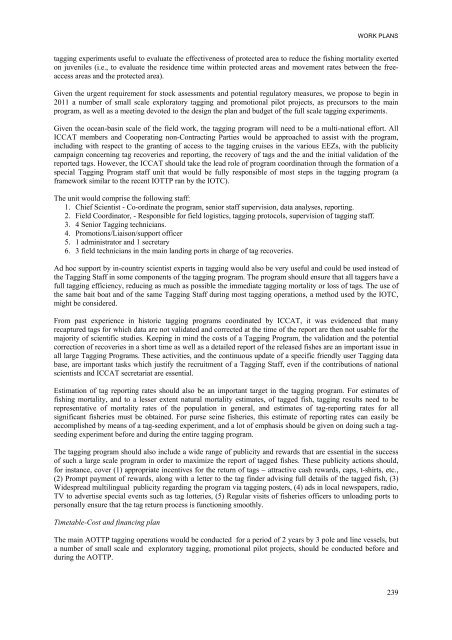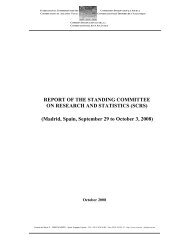REPORT OF THE STANDING COMMITTEE ON RESEARCH ... - Iccat
REPORT OF THE STANDING COMMITTEE ON RESEARCH ... - Iccat
REPORT OF THE STANDING COMMITTEE ON RESEARCH ... - Iccat
Create successful ePaper yourself
Turn your PDF publications into a flip-book with our unique Google optimized e-Paper software.
WORK PLANS<br />
tagging experiments useful to evaluate the effectiveness of protected area to reduce the fishing mortality exerted<br />
on juveniles (i.e., to evaluate the residence time within protected areas and movement rates between the freeaccess<br />
areas and the protected area).<br />
Given the urgent requirement for stock assessments and potential regulatory measures, we propose to begin in<br />
2011 a number of small scale exploratory tagging and promotional pilot projects, as precursors to the main<br />
program, as well as a meeting devoted to the design the plan and budget of the full scale tagging experiments.<br />
Given the ocean-basin scale of the field work, the tagging program will need to be a multi-national effort. All<br />
ICCAT members and Cooperating non-Contracting Parties would be approached to assist with the program,<br />
including with respect to the granting of access to the tagging cruises in the various EEZs, with the publicity<br />
campaign concerning tag recoveries and reporting, the recovery of tags and the and the initial validation of the<br />
reported tags. However, the ICCAT should take the lead role of program coordination through the formation of a<br />
special Tagging Program staff unit that would be fully responsible of most steps in the tagging program (a<br />
framework similar to the recent IOTTP ran by the IOTC).<br />
The unit would comprise the following staff:<br />
1. Chief Scientist - Co-ordinate the program, senior staff supervision, data analyses, reporting.<br />
2. Field Coordinator, - Responsible for field logistics, tagging protocols, supervision of tagging staff.<br />
3. 4 Senior Tagging technicians.<br />
4. Promotions/Liaison/support officer<br />
5. 1 administrator and 1 secretary<br />
6. 3 field technicians in the main landing ports in charge of tag recoveries.<br />
Ad hoc support by in-country scientist experts in tagging would also be very useful and could be used instead of<br />
the Tagging Staff in some components of the tagging program. The program should ensure that all taggers have a<br />
full tagging efficiency, reducing as much as possible the immediate tagging mortality or loss of tags. The use of<br />
the same bait boat and of the same Tagging Staff during most tagging operations, a method used by the IOTC,<br />
might be considered.<br />
From past experience in historic tagging programs coordinated by ICCAT, it was evidenced that many<br />
recaptured tags for which data are not validated and corrected at the time of the report are then not usable for the<br />
majority of scientific studies. Keeping in mind the costs of a Tagging Program, the validation and the potential<br />
correction of recoveries in a short time as well as a detailed report of the released fishes are an important issue in<br />
all large Tagging Programs. These activities, and the continuous update of a specific friendly user Tagging data<br />
base, are important tasks which justify the recruitment of a Tagging Staff, even if the contributions of national<br />
scientists and ICCAT secretariat are essential.<br />
Estimation of tag reporting rates should also be an important target in the tagging program. For estimates of<br />
fishing mortality, and to a lesser extent natural mortality estimates, of tagged fish, tagging results need to be<br />
representative of mortality rates of the population in general, and estimates of tag-reporting rates for all<br />
significant fisheries must be obtained. For purse seine fisheries, this estimate of reporting rates can easily be<br />
accomplished by means of a tag-seeding experiment, and a lot of emphasis should be given on doing such a tagseeding<br />
experiment before and during the entire tagging program.<br />
The tagging program should also include a wide range of publicity and rewards that are essential in the success<br />
of such a large scale program in order to maximize the report of tagged fishes. These publicity actions should,<br />
for instance, cover (1) appropriate incentives for the return of tags attractive cash rewards, caps, t-shirts, etc.,<br />
(2) Prompt payment of rewards, along with a letter to the tag finder advising full details of the tagged fish, (3)<br />
Widespread multilingual publicity regarding the program via tagging posters, (4) ads in local newspapers, radio,<br />
TV to advertise special events such as tag lotteries, (5) Regular visits of fisheries officers to unloading ports to<br />
personally ensure that the tag return process is functioning smoothly.<br />
Timetable-Cost and financing plan<br />
The main AOTTP tagging operations would be conducted for a period of 2 years by 3 pole and line vessels, but<br />
a number of small scale and exploratory tagging, promotional pilot projects, should be conducted before and<br />
during the AOTTP.<br />
239

















